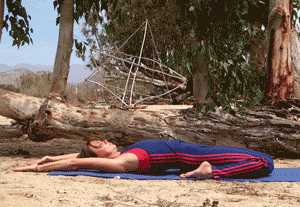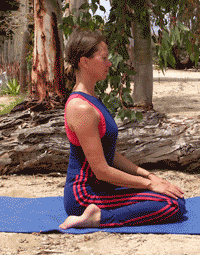 |
|
| Site Areas |
store | | | articles | | | forums | | | studios | | | vacations |
| yoga | massage | fitness | wellness | readings | ask the expert | |
Supta Virasana : The Reclining Hero PostureYogiSource.com Staff©Yoga People, LLC 2017 Pronunciation: (Soup-tah) (veer-AWS-ahna) Translation:
 This pose stretches the quadriceps muscles in your top legs, helps open your hips and stimulates your digestion. You are more likely to have tight hip flexors or iliopsoas muscles if you sit at a desk for a long time each day. This can create poor posture by pulling your pelvis forward and down. It can eventually lead to a “sway back” with a lumbar spine that is arched too much and to back problems. Supta Virasana stretches your hip flexors and contributes to a more healthy back. This pose has a remarkable effect on digestion. It is one of the yoga poses you can do after eating. At a recent yoga teacher’s training in Mexico, we were all getting used to the food and new setting. Many of the students were constipated. The instructor, Victor Oppenheimer, heard about this problem that people were having, so he taught them Supta Virasana. After doing the pose in class, half the pupils left to go to the outhouse! We suggest this pose for travel and for times when you have digestive upset. Because Supta Virasana stretches the quadriceps muscles, it helps protect the knees from new injuries as well as contributing to the recovery from knee injuries such as ripped medial meniscus cartilage. If the knees are swollen the stretch that this pose provides to the knees can squeeze excess fluid from the knees and reduce the swelling and discomfort. Eventually, for some, Supta Virasana can become a resting pose, not a stretching pose though it takes some practice to get to that point. Technique:
 Begin in Virasana. Kneel with your knees together and near the front of the mat. The tops of the feet should be hip width apart on the mat and parallel to each other. In Virasana, you sit between your feet rather than on the feet as in the Vajrasana pose. In the both Virasana and Supta Virasana your kneecaps should be aligned vertically rather than tilting. If you hold onto your calves and roll them to the outside while you roll your upper thighs inwards as you lower yourself into the pose you will usually bring your kneecaps into better vertical alignment. If your hips sink low enough, the inner sides of your feet should touch the sides of your hips. If your hips do not fully descend, the feet should still be positioned so that the hips would be between them if you could descend lower. The weight on the top of each of your toes should be equal. If your heels swing in towards your hips then there will be more weight on the tops of the inside of each foot then the outside. Correct this by moving your heels out until the weight is equally distributed. One by one, lift each knee, slide your hand under it and use your fingers to move the skin of the shin up towards your knees. This releases some knee pressure. Now you are kneeling in Virasana (see photo). Stay for a moment and then descend mindfully into Supta Virasana. To descend, press your palms into the floor as you bend the elbows and gradually extend back toward your prop or the floor. The knees extend in one direction away from the pelvis and down towards the floor as you also extend the upper torso in the opposite direction away from the pelvis and lower the shoulders to or towards the floor. To protect your lower back in this pose, it is important to avoid over-arching it during the descent. This is done by tilting your pelvis so that your coccyx moves upwards between your legs towards your pubic bone as you also move the ribcage up from the hips towards your head. This creates space between the vertebrae in your lower back. Keep performing this protective maneuver as you also maintain the descent of the buttocks towards the earth beneath you. Keep your knees together and firmly on the floor. Remember to focus on lowering your shoulders rather than arching the neck and lowering your head. Your chest is expanded by lifting your sternum upward and away from your pubic bone. The lengthening of the torso that happens when you lift the sternum creates deep space to facilitate breath. Extend the neck with a relaxed throat. The neck should be in a neutral position, not overly arched. Relax the thighs and abdomen. The thighs have a tendency to fall inward. Revolve the thighs outward so that they face the ceiling. Stay in the pose for a minute, and in the future you can practice so that you can stay in the pose for 5-10 minutes. To come out of the pose, push yourself up with your hands and return to kneeling in Virasana. Come up to your knees, crossing your legs behind coming into Sukhasana (seated cross-legged pose). Now extend your legs in front of you to stretch them out. Dandasana and Paschimottanasana are perfect poses to do after Supta Virasana because you will enjoy stretching out your knees at this point. Prop Use: 1. You cannot lower your shoulders down as far as the floor at all or, if you can, it is only at the expense of over arching the lower back. This usually occurs because the quadriceps muscles (that run the length of the backs of your thighs) are too short. To alleviate the discomfort and relieve the lumbar arching build a stack of some folded blankets that extends from behind your buttocks to your head. The stack should be high enough so that you can place your shoulders down on it without the arching of your lower back. Over time as your quadriceps muscles become longer you will find that the height of the stack can be lowered. 3. You feel knee pain. Knee pain can be a consequence of the angle of the patella (kneecap) and/or inner knee injury. First, be sure that you have rolled the calves out and thighs in as described above. If this doesn’t adequately relieve the discomfort, try putting a support such as a rolled washcloth deep into the inner knee before lowering yourself into Virasana. If the discomfort still persists, consult a competent teacher. 4. Your neck is arching back and getting crunched. In order to avoid overarching the neck it is often helpful to put a small blanket under the head. Beginner’s Tip: Variations: Benefits: Contraindications/Cautions: Special thanks to long-time yoga instructor Victor Oppenheimer for offering suggestions for the and editing. ©2006 Yoga People LLC All rights reserved |
| about us | contact | privacy | site map | careers | |

|
|